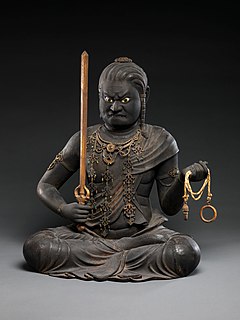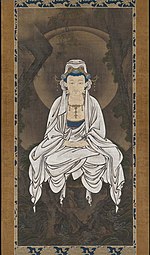อจละ
| อจละ | |
|---|---|
 ประติมากรรมฟูโดเมียวโอ (Fudō Myōō) หรือ อจละ, ต้นคริสต์ศตวรรษที่ 13 (ยุคคามากูระ), ประเทศญี่ปุ่น | |
| สันสกฤต |
|
| จีน |
|
| ญี่ปุ่น |
|
| เกาหลี | 부동명왕 (Budong Myeongwang) |
| มองโกเลีย | Хөдөлшгүй (Khödölshgüi) |
| ทิเบต | མི་གཡོ་བ་ (Miyowa) |
| เวียดนาม | Bất Động Minh Vương |
| ข้อมูล | |
| นับถือใน | วัชรยาน, มหายาน, ชูงเกงโด |
| พระลักษณะ | วัชระ, บ่วง (บาศ), sword |
อจละ (สันสกฤต: अचल, "ไม่หวั่นไหว) หรือ อจลนาถ (अचलनाथ, "ท้าวผู้ไม่หวั่นไหว") หรือ อารยาจลนาถ (आर्याचलनाथ, "ท้าวผู้ไม่หวั่นไหวผู้ยิ่งใหญ่") เป็นโกรธวิฆนันตกะและธรรมปาลในศาสนาพุทธ ปรากฏเป็นหลักในวัชรยานกับพุทธแบบเอเชียตะวันออก[1]
ดั้งเดิมแล้ว อจละเป็นเทวดาองค์รองที่มีหน้าที่เป็นทูตหรือผู้ช่วยของพระไวโรจนพุทธะ ต่อมาอจละจึงกลายมาเป็นเทวดาที่มีจารีตบูชาตนเองในฐานะผู้กำจัดอุปสรรคหรือผู้ทำลายความชั่ว จนในที่สุดบางจารีตเชื่อว่าอจละเป็นปางโกรธ ดุร้าย ของพระไวโรจนพุทธะ, พระอักโษภยพุทธะ หรือ พระโพธิสัตว์มัญชุศรี ในคัมภีร์ยุคหลังยังปรากฏการเรียกอจละว่า จัณฑโรษณะ (चण्डरोषण; Caṇḍaroṣaṇa, "ผู้ดุร้ายรุนแรง") หรือ จัณฑมหาโรษณะ (चण्डमहारोषण; Caṇḍamahāroṣaṇa, "ผู้รุนแรงที่ดุร้าย") โดยสองนามหลังปรากฏมากในเนปาลและทิเบต[2][3][4]
ในพุทธแบบตะวันออกนิกายเจินเหยียนถือว่าอจละเป็นหนึ่งในวิทยราชทั้งห้าแห่งครรภโกษธาตุ อจละจึงมีสถานะที่สำคัญทั้งในครรภโกษธาตุมณฑลและวัชรธาตุมณฑล (มณฑลเรียวไก) ในพุทธแบบจีนเรียกอจละว่า ปู้ต้งหมิงหวัง (不動明王, "ราชาแห่งปัญญาผู้ไม่หวั่นไหว", คำแปลภาษาจีนจาก อจลวิทยราช[5]) ส่วนในญี่ปุ่นเรียกว่า ฟูโดเมียวโอ (Fudō Myōō) ซึ่งเป็นการออกเสียงแบบ องโยมิ จากชื่อในภาษาจีน[6]
อ้างอิง
- ↑ Murakami 1988, Jp. rel. dict., pp. 242–246
- ↑ Weston, David (2018). "The Bayer Collection — University of Glasgow" (PDF). The Bayer Collection. คลังข้อมูลเก่าเก็บจากแหล่งเดิม (PDF)เมื่อ 2021-08-23. สืบค้นเมื่อ 2021-08-23.
- ↑ Donaldson, Thomas E. (2001). Iconography of the Buddhist Sculpture of Orissa: Text. Indira Gandhi National Centre for the Arts. pp. 219–221. ISBN 978-0-486-25575-0.
- ↑ Hugo Kreijger (1999). Kathmandu Valley painting: the Jucker collection. Shambhala. p. 123. ISBN 978-1-57062-454-4.
- ↑ Goble, Geoffrey C. (2019). Chinese Esoteric Buddhism: Amoghavajra, the Ruling Elite, and the Emergence of a Tradition (ภาษาอังกฤษ). Columbia University Press. p. 65. ISBN 978-0-231-55064-2.
- ↑ Fudō Myōō and Myō-ō, Encyclopædia Britannica
Text is available under the CC BY-SA 4.0 license; additional terms may apply.
Images, videos and audio are available under their respective licenses.

